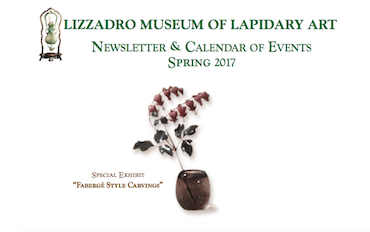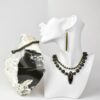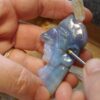Spring 2017
Interpreting Chinese Jade Pendants
By Ying Zhang
As one of many forms into which raw jade materials are crafted, jade pendants became popular during the Ming and Qing Dynasty (AD 1368-1912), the Late Imperial Period in Chinese history. Jade pendants are often made in square or rectangular shapes, and are relatively small in terms of size, because jade pendants are designed as personal accessories. Ancient Chinese people usually wore jade pendants using a string to hang from the waist.
As the pendants were meant to hang from the waist or the neck, there is a hole at the top of each pendant so the string can be threaded through. There are two sides of the jade pendants that craftsman would carve on: the front side presents scenes, patterns, or objects, while the back side is usually carved with poems or mottos. The contents of the front and back side echo mutually and deliver the same allegorical message. Because of its size and the auspicious meaning it carries, the jade pendant is very convenient to wear and ancient literati or aristocracy were fond of the small but exquisite pieces of jade.
During the Imperial Period the most popular designs involved auspicious symbolism. Thematic patterns on the front side may include a wide range of images: scenes of landscape, stories of historical figures, flowers and plants, rare and valuable animals, and hermits. Moreover, auspicious blessings are conveyed with methods of homophonic analogy, symbolization, or metaphor. For example, the “lock” jade pendant (pictured here) from the Lizzadro Collection exemplifies the metaphorical principle.
The flower on the front side of the piece is called peony, “牡丹 mǔ dān,” which symbolizes prosperity, wealth, and flourishing. The flower species peony is also the national flower of China; its symbolization of prosperity could anticipate a prosperous and thriving society.
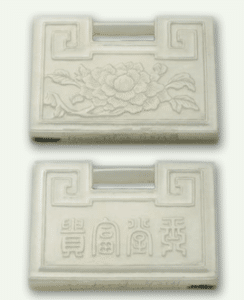
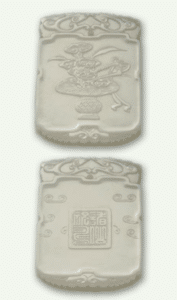
The back side of the “lock” piece is carved with four traditional Chinese characters, reading from left to right: 玉堂富貴 yù tang fù guì, translates “wish the honorable household prosperity and wealth.” Also, flowers like begonia, peony, magnolia, are culturally associated with the meaning of prosperity and luxuriance. In addition, the shape of the lock indicates that the lock stores and locks the prosperity and wealth in it. In this way, the lock shape itself is a metaphor for the action of storing and collecting good fortune.
Another pendant features língzhī (pronounced in English “ling zhur”) 靈芝, a fungal species that is venerated as the “Mushroom of Immortality.” Pictured here, the língzhī is bottled in a vase with beautiful ribbons. This special fungal species, or reishi, has been used in Chinese medicine for over 2000 years and culturally refers to longevity and immortality. Double dragons face each other on the top.
The back of the pendant depicts several cloud motifs, the square seal writes “諸仙祝壽,” meaning “all the immortal divines congratulate you with the blessings for longevity.”
Fourteen of the Museum’s jade pendants were interpreted to discover their meaning and symbolism. Just one small piece of beautifully carved jade can refer to literature, Chinese calligraphy, auspicious symbols and historical stories. These pendants were welcomed by the Ming and Qing people, but are also relevant to modern people. Jade pendants today are highly collectable and continue to be produced in China. The Lizzadro Collection has a wide range of different kinds of jade pendants, so be sure to take another look at the display.
Special thanks to Ying Zhang for her work in interpreting pendants and carvings in the Lizzadro Collection, we wish her all the best as she goes on to pursue her doctoral studies.
Twenty-one years ago the Smithsonian Institution created a national outreach program that would extend the reach of the Smithsonian collections to communities, museums and research organizations across the nation. To fulfill the Smithsonian’s mission for the “increase and diffusion of knowledge,” Smithsonian Affiliations was created to provide access to Smithsonian collections. The program’s goal was to make sure those who cannot travel to Washington, D.C., could experience and enjoy the Smithsonian in their own neighborhoods.
Today, the program has established partnerships with more than 200 organizations in 45 states, Puerto Rico and Panama. The Lizzadro Museum became an Affiliate member in the fall of 2008. We look forward to bringing an exhibit of Smithsonian Gems this summer.
All Aboard the Explore Elmhurst Express!
Looking for an adventure this summer? Take a free ride on the Explore Elmhurst Express trolley running weekends from June 2 through September 16! Explore the heart of Elmhurst including Museums, Wilder Park, shops and restaurants. For more information visit ExploreElmhurst.com.

